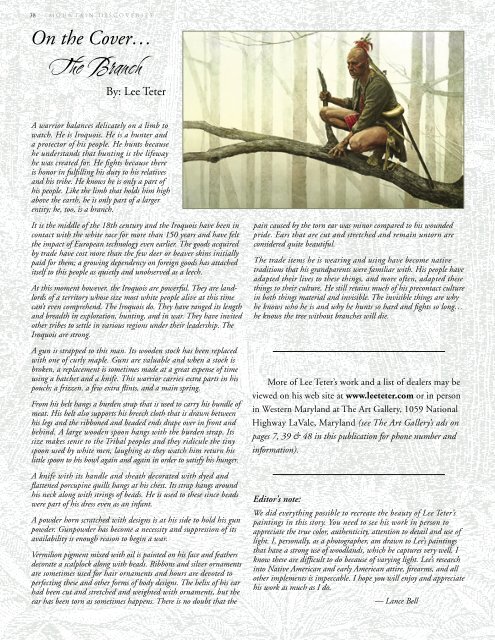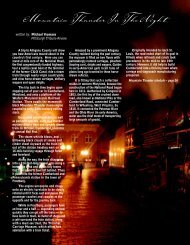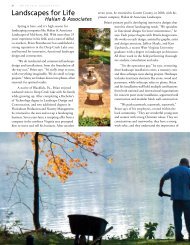Lee Teter - Mountain Discoveries Magazine
Lee Teter - Mountain Discoveries Magazine
Lee Teter - Mountain Discoveries Magazine
You also want an ePaper? Increase the reach of your titles
YUMPU automatically turns print PDFs into web optimized ePapers that Google loves.
38 m o u n t a i n d i s c o v e r i e s<br />
On the Cover…<br />
The Branch<br />
By: <strong>Lee</strong> <strong>Teter</strong><br />
A warrior balances delicately on a limb to<br />
watch. He is Iroquois. He is a hunter and<br />
a protector of his people. He hunts because<br />
he understands that hunting is the lifeway<br />
he was created for. He fights because there<br />
is honor in fulfilling his duty to his relatives<br />
and his tribe. He knows he is only a part of<br />
his people. Like the limb that holds him high<br />
above the earth, he is only part of a larger<br />
entity; he, too, is a branch.<br />
It is the middle of the 18th century and the Iroquois have been in<br />
contact with the white race for more than 150 years and have felt<br />
the impact of European technology even earlier. The goods acquired<br />
by trade have cost more than the few deer or beaver skins initially<br />
paid for them; a growing dependency on foreign goods has attached<br />
itself to this people as quietly and unobserved as a leech.<br />
At this moment however, the Iroquois are powerful. They are landlords<br />
of a territory whose size most white people alive at this time<br />
can’t even comprehend. The Iroquois do. They have ranged its length<br />
and breadth in exploration, hunting, and in war. They have invited<br />
other tribes to settle in various regions under their leadership. The<br />
Iroquois are strong.<br />
A gun is strapped to this man. Its wooden stock has been replaced<br />
with one of curly maple. Guns are valuable and when a stock is<br />
broken, a replacement is sometimes made at a great expense of time<br />
using a hatchet and a knife. This warrior carries extra parts in his<br />
pouch; a frizzen, a few extra flints, and a main spring.<br />
From his belt hangs a burden strap that is used to carry his bundle of<br />
meat. His belt also supports his breech cloth that is drawn between<br />
his legs and the ribboned and beaded ends drape over in front and<br />
behind. A large wooden spoon hangs with the burden strap. Its<br />
size makes sense to the Tribal peoples and they ridicule the tiny<br />
spoon used by white men, laughing as they watch him return his<br />
little spoon to his bowl again and again in order to satisfy his hunger.<br />
A knife with its handle and sheath decorated with dyed and<br />
flattened porcupine quills hangs at his chest. Its strap hangs around<br />
his neck along with strings of beads. He is used to these since beads<br />
were part of his dress even as an infant.<br />
A powder horn scratched with designs is at his side to hold his gun<br />
powder. Gunpowder has become a necessity and suppression of its<br />
availability is enough reason to begin a war.<br />
Vermilion pigment mixed with oil is painted on his face and feathers<br />
decorate a scalplock along with beads. Ribbons and silver ornaments<br />
are sometimes used for hair ornaments and hours are devoted to<br />
perfecting these and other forms of body designs. The helix of his ear<br />
had been cut and stretched and weighted with ornaments, but the<br />
ear has been torn as sometimes happens. There is no doubt that the<br />
pain caused by the torn ear was minor compared to his wounded<br />
pride. Ears that are cut and stretched and remain untorn are<br />
considered quite beautiful.<br />
The trade items he is wearing and using have become native<br />
traditions that his grandparents were familiar with. His people have<br />
adapted their lives to these things, and more often, adapted these<br />
things to their culture. He still retains much of his precontact culture<br />
in both things material and invisible. The invisible things are why<br />
he knows who he is and why he hunts so hard and fights so long…<br />
he knows the tree without branches will die.<br />
More of <strong>Lee</strong> <strong>Teter</strong>’s work and a list of dealers may be<br />
viewed on his web site at www.leeteter.com or in person<br />
in Western Maryland at The Art Gallery, 1059 National<br />
Highway LaVale, Maryland (see The Art Gallery’s ads on<br />
pages 7, 39 & 48 in this publication for phone number and<br />
information).<br />
Editor’s note:<br />
We did everything possible to recreate the beauty of <strong>Lee</strong> <strong>Teter</strong>’s<br />
paintings in this story. You need to see his work in person to<br />
appreciate the true color, authenticity, attention to detail and use of<br />
light. I, personally, as a photographer, am drawn to <strong>Lee</strong>’s paintings<br />
that have a strong use of woodlands, which he captures very well. I<br />
know these are difficult to do because of varying light. <strong>Lee</strong>’s research<br />
into Native American and early American attire, firearms, and all<br />
other implements is impeccable. I hope you will enjoy and appreciate<br />
his work as much as I do.<br />
— Lance Bell




